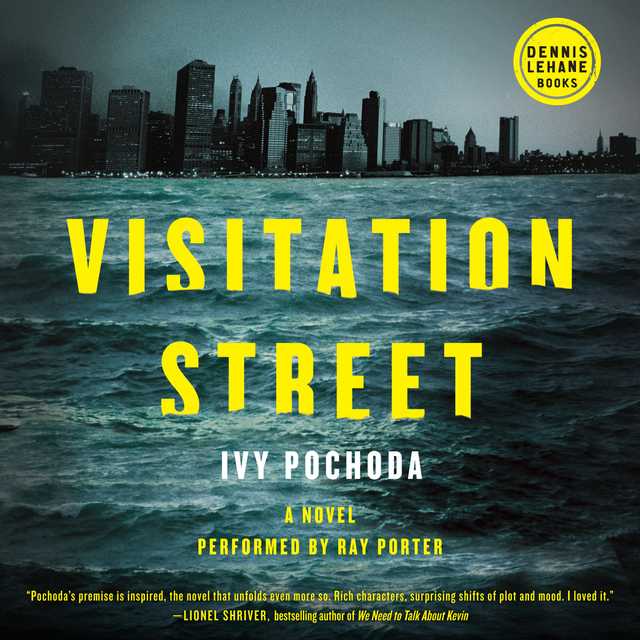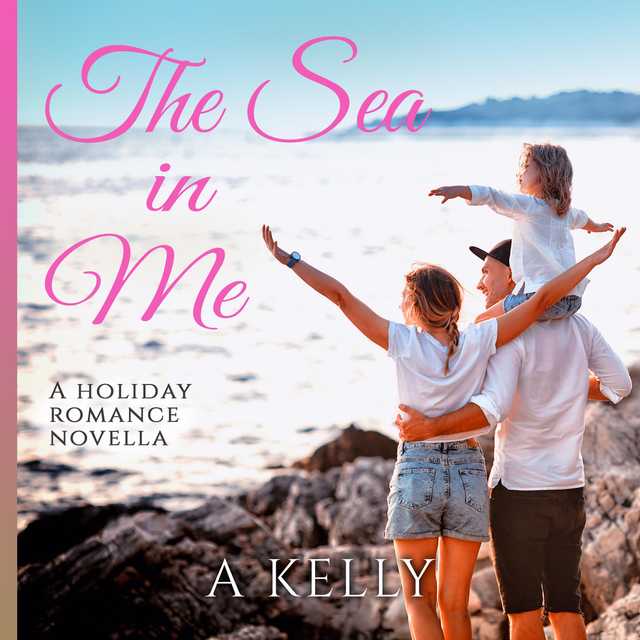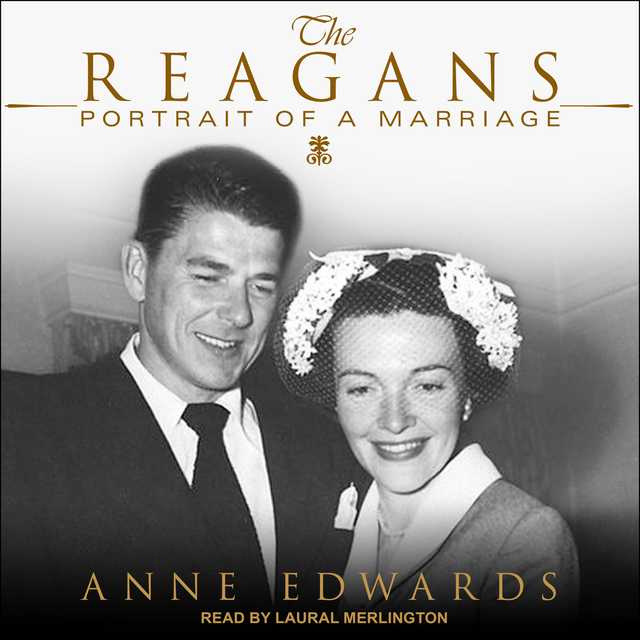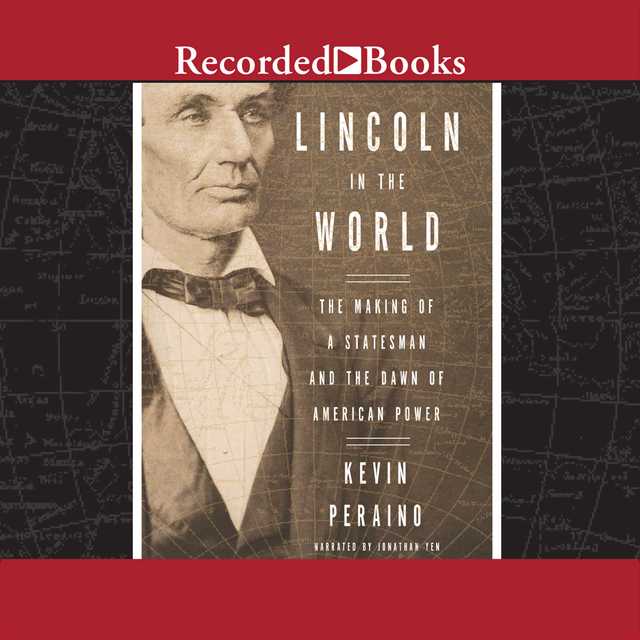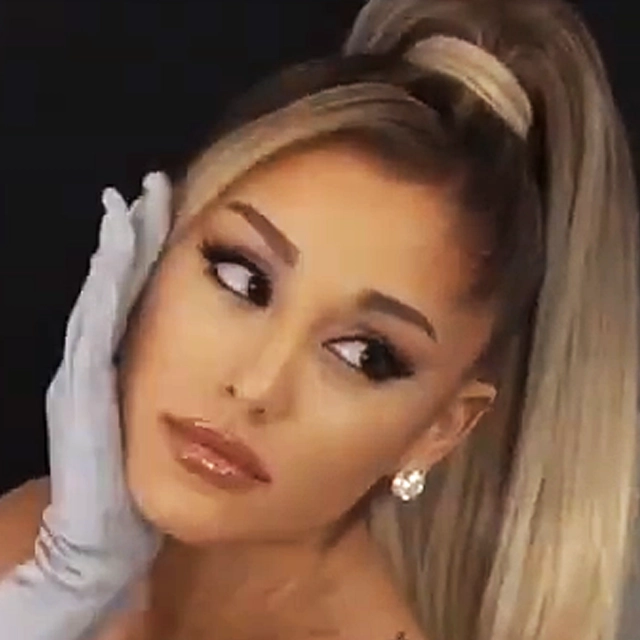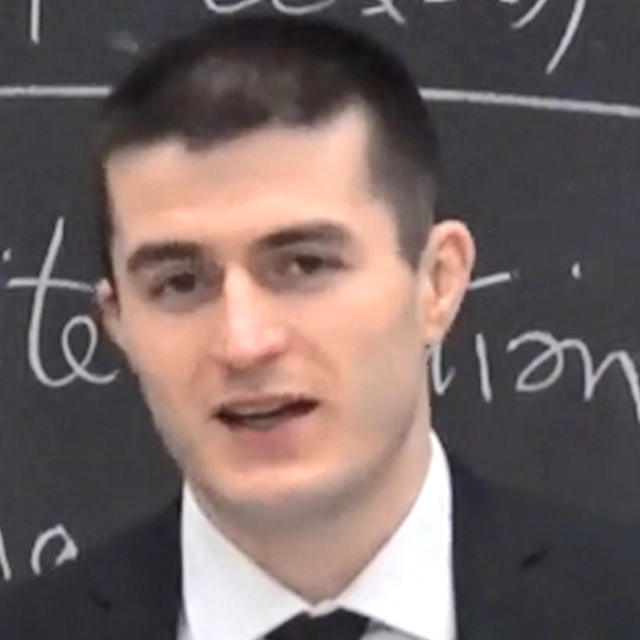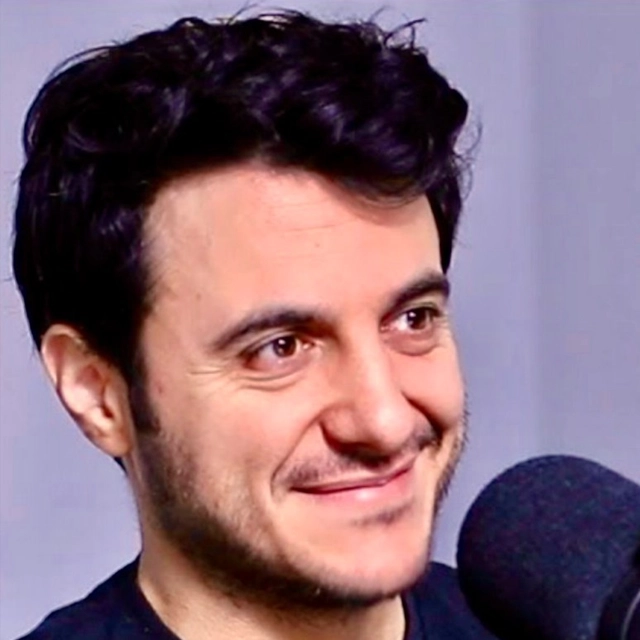Visitation Street Audiobook Summary
Chosen by Dennis Lehane for his eponymous imprint, Ivy Pochoda’s Visitation Street is a riveting literary mystery set against the rough-hewn backdrop of the New York waterfront in Red Hook.
It’s summertime in Red Hook, Brooklyn, a blue-collar dockside neighborhood. June and Val, two fifteen-year-olds, take a raft out onto the bay at night to see what they can see.
And then they disappear. Only Val will survive, washed ashore; semi-conscious in the weeds.
This shocking event will echo through the lives of a diverse cast of Red Hook residents. Fadi, the Lebanese bodega owner, hopes that his shop will be the place to share neighborhood news and troll for information about June’s disappearance. Cree, just beginning to pull it together after his father’s murder, unwittingly makes himself the chief suspect, but an enigmatic and elusive guardian is determined to keep him safe.
Val contends with the shadow of her missing friend and a truth she buries deep inside. Her teacher Jonathan, a Julliard School dropout and barfly, wrestles with dashed dreams and a past riddled with tragic sins.
Other Top Audiobooks
Visitation Street Audiobook Narrator
Ray Porter is the narrator of Visitation Street audiobook that was written by Ivy Pochoda
About the Author(s) of Visitation Street
Ivy Pochoda is the author of Visitation Street
More From the Same
- Author : Ivy Pochoda
- Wonder Valley
- These Women
- Sing Her Down
- Publisher : HarperAudio
- Abraham
- American Gods [TV Tie-In]
- Dead Ringer
- House of Sand and Fog
- Prey
Visitation Street Full Details
| Narrator | Ray Porter |
| Length | 9 hours 32 minutes |
| Author | Ivy Pochoda |
| Category | |
| Publisher | HarperAudio |
| Release date | July 09, 2013 |
| ISBN | 9780062272973 |
Additional info
The publisher of the Visitation Street is HarperAudio. The imprint is HarperAudio. It is supplied by HarperAudio. The ISBN-13 is 9780062272973.
Global Availability
This book is only available in the United States.
Goodreads Reviews
Will
February 17, 2021
If Ivy Pochoda never writes another book, this one would be enough to keep her name on the lips of readers for decades to come. On a hot July night in Brooklyn’s Red Hook neighborhood, (named, BTW, for the color of its soil and an erstwhile geographical point, not for the hook-shaped pier that juts out from it today) two fifteen-year-old girls, Val Marino and June Giotta, looking for a little fun, take a small raft out into the city’s upper bay. Only one returns, found unconscious under the pylons of a local pier. What happened?There is danger in being in love. When we are in love we tend to lift up the things about our beloved that appeal, while minimizing, if we see at all, the things that do not. My feeling about Visitation Street reminds me of that. There is an air of ecstasy about it, as if I have found The One. And maybe there are flaws that I simply cannot see because of the overwhelming feeling of excitement that I experienced while reading this book. For what it’s worth, I have had this feeling several times in the last few years, with The Orchardist, Caribou Island, Billy Lynn's Long Half-Time Walk, and Skippy Dies, to name a few. I have not felt any regret about declaring my love for them, and do not expect any regrets this time around. But just so’s ya know. Ahm in luuuuv. My wife understands.This is a magnificent book, very reminiscent in power and achievement to Dennis Lehane’s Mystic River. In fact the book is released under the imprint Dennis Lehane Books, and seeing how reminiscent it is of Mystic River that seems appropriate. Ivy Pochoda has achieved a stunning success in so many ways in Visitation Street that it is difficult to know where to begin. How about characters? Pochoda clearly has a gift for portraying people. Val is struggling to remember what happened that night, and we feel her pain as she travels from forgetting to remembrance. Eighteen-year-old Acretius James, Cree, struggles to overcome the death of his Corrections Officer father, Marcus, and to find direction in his life. He spends a lot of his time on a beached boat left by his dad.[Was this boat, seen on a pier off Beard Street, the inspiration for this?]Will he remain moored in the rubble of the past or find a way to sail forth? Jonathan Sprouse, a musician and music teacher at a local parochial school, and borderline alcoholic, has a lifetime of descent interrupted by an opportunity to do something worthwhile. He hears the world differently from you and me. The wino’s voice catches Jonathan’s ear. It’s dissonant, all flats and sharps with no clear words. and later Nearly every day Jonathan tells Fadi about a piece of music that’s perfectly suited to the moment. Last week he said, “It’s an afternoon for Gershwin. Mostly sunny, a little snappy, but with a hint of rain.” And two evenings ago he asked. “Did you see the sunset? Only Philip Glass could write a sunset like that.”Fadi is a bodega owner, invested in helping his community, and he works to try to unravel the mystery of what happened to Laura Palmer June Giotta. (and what is going on across the street from his shop with the owner of that place and the wino who seems always to be hanging out there?)[Here is the real-world place that provided the model for Fadi’s]Finally, Ren is a mysterious protector who appears, seemingly out of nowhere, to watch over Cree and Val. (For those who are familiar, think the Super-Hoodie character in the British TV series, Misfits ) Pochoda makes us care about every one of these people. She breathes life into them, giving us reasons to want them to succeed. We feel the love for these characters that their creator obviously does. But they are all, well, except for Fadi, damaged people, sinking, needing a life preserver of one sort or another. Val is a basket case after that night. Jonathan was born playing first violin and somehow finds himself at the back of the orchestra. Cree suffers from the loss of his father and Ren has a dark past that has defined much of his life. But they struggle to rise above the waves, and we cheer their efforts.Next is the landscape, which, in this case, is the most significant character in the story. When SuperBitch Sandy raised the ocean's wrath in 2012, devastating large swaths of the East Coast, it was not the first time that Red Hook had been laid waste. The area had once been the primary entryway of grain to the nation. Large proportions of the nation's sugar was imported and refined in Red Hook, and a considerable swath of the metro area's beer was processed there. But the dock jobs moved to newer ports, the neighborhood was bisected when Robert Moses carved an elevated trench through it with the construction of the Gowanus Expressway, and the crack epidemic led Red Hook to be declared one of the worst neighborhoods in the nation in 1990. But Red Hook had been making a comeback. A new frou-frou supermarket has been built in a Civil War era waterfront building (it is referred to in the book as Local Harvest, but is in reality a Fairway. I have shopped there and it is fabulous, or at least it was before Sandy destroyed it. It reopened in March 2013) The story is set in 2006. There is now an IKEA in Red Hook, occupying what was an abandoned dockyard at the time of the story. On the next pier down was an abandoned sugar refinery, which was demolished in 2007, so don’t go looking. This image was found in Gothamist.com and permission was granted to use it hereA cruise ship terminal, imminent for most of the book, is opened by the end.The Queen Mary II, at the Brooklyn Cruise Terminal - 7/6/13The change in the neighborhood is part of the world Pochoda describes. There is, by the way, a Visitation Place, on which is located a Visitation rectory. We presume that the day care center at which the girls worked is there as well. There is a real Red Hook Gospel Tabernacle to match the one in the story. People were indeed killed in this neighborhood from drug-related gang violence, most notably a school principal who had walked out of his public school looking for one of his students, and took a stray round. In the Red Hook Houses, recently devastated by Sandy, reside some 8,000 people, in less than idyllic conditions. It is still a tough place.So we have amazing characters and a spot-on depiction of a neighborhood in transition from drug center to the next cool place. Next comes plot. There is indeed a compelling mystery, and Pochoda is no less skilled at peeling back the layers in that than she is in revealing her characters, bit by bit. You will want to know what took place and Pochoda will let you know, in due time. Next is the introduction of a dose of magical realism. Cree’s mother, Gloria, has the sight. Enough of a talent to spend countless days talking (visiting?) with her dead husband, while sitting on the memorial bench that had been erected to his memory. (This was inspired by the death of that public school principal. A school was named for him. Cree’s father must make do with the bench.) Enough of a talent that locals come to her for help in communicating with their dearly departed. That particular strand of DNA did not come to Cree, but his grandmother and his aunt also have the ability, and there may be another family member in line as well. After that night, Val sees and hears things. Is she losing her mind? She is not alone. How the people visited by these incomings handle the stress of it is a significant element of the tale as well. Is it real at all or merely the self-inflicted manifestation of guilt?The notion of ghosts is prominent here in Pochoda’s Red Hook. Certainly the death of Cree’s father is a spectre that continues to impact both his son and his widow. Jonathan carries with him the burden of a death as well. Val must cope with the death of her friend, and Ren not only has death-related memories that live on for him, but has seen the torment of many others. There wasn’t a goddamned night on the inside when I wasn’t woken by somebody haunted by the person he dropped. Ghosts aren’t the dead. They’re those the dead left behind. Stay here long enough, you’ll become one of them—another ghost haunting the Hook.Cree’s mother communes daily with her late husband. And the neighborhood itself echoes with the change from is to was: As he crosses from this abandoned corner of the waterside back over to the Houses he becomes aware of the layers that form the Hook—the projects built over the frame houses, the pavement laid over the cobblestones, the lofts overtaking the factories, the grocery stores overlapping the warehouses. The new bars cannibalizing the old ones. The skeletons of forgotten buildings—the sugar refinery and the dry dock—surviving among the new concrete bunkers being passed off as luxury living. The living walk on top of the dead—the water front dead, the old mob dead, the drug war dead—everyone still there. A neighborhood of ghosts.I expect that by including references to sundry locations that have now moved on to another realm, Pochoda is linking the deaths and births on the landscape with the more human ghosts that inhabit this world. All these incredible characters come to life in this book, even though they are walking through a place as haunted as any graveyard.The final piece here is the power of Pochoda’s writing. Here is a sample. The women grow grungier and sexier the later it gets. Soon they bear no resemblance to the morning commuters who will tuck themselves into bus shelters along Van Brunt on Monday, polished and brushed and reasonably presentable to the world outside Red Hook. Nighttime abrades them, tangles their hair and chips their nails. Colors their speech. At night, the hundreds of nights they’ve passed the same way begin to show, revealed in their hollowed cheeks and rapid speech. Jonathan wonders how long it takes for their costumes to become their clothes, their tattoos their birthmarks. When will they let the outside world slip away and forget to retrieve it?Really, what could possibly be added to enhance that? Ok, there have to be a few chinks in the armor here, somewhere, right? I looked pretty closely at the geography of the events, and it seemed a stretch. For example, did Jonathan really carry the unconscious Val eight blocks to Fadi’s? Well, he is a young guy, 28, 29, so yeah, I guess it is possible. There is no inpatient hospital in Red Hook, and I have not yet found out whether there was one there in 2006. But I continue to search. The four-corners location which includes Fadi’s bodega appears to be located not at the intersection of Visitation and Van Brunt, but a block away at Pioneer Street. These are small items, and I have no trouble with the author using a bit of elastic geography to support her story. Certainly “Visitation “works better than “Pioneer,” the actual name of the street where the bar and bodega intersect Van Brunt, particularly as characters here are visited, in one way or another. This not a book you will want to begin before bedtime, as you may find yourself reading straight through and costing yourself a good chunk of a night’s sleep. We are in can’t-put-it-down territory here. And you might want to have a good cardiologist nearby when you finish reading this book. It’s gonna break your heart. It’s no secret. I love this book. But I’m a modern guy and this is not an exclusive love. I am more than happy to share. Don’t let this one sink beneath the waves of your attention. Reach in and pull it out. This is simply an amazing book. You must read it. ==========In the summer of 2019 GR reduced the allowable review size by 25%, from 20,000 to 15,000 characters. In order to accommodate the text beyond that I have moved it to the comments section directly below.
karen
September 27, 2018
oh, good - a love letter to brooklyn. i was beginning to think NO ONE would EVER write a book about this forgotten borough. humph. and what do we have, sitting here in queens eating refried beans?crickets.but still. this is a fantastic book. not for the mystery element; that is pretty much secondary. no, make that tertiary. first and foremost, it is, indeed, a love letter to red hook. red hook is a section of brooklyn with which i am not overly familiar. but after reading this, i feel like i know everything about it. or at least how it was in 2006, when this book takes place, when red hook is on the very cusp of gentrification. lord knows it is probably completely overrun with hipsters and organic gastropubs by now. a quick aside about gentrification, which you can choose to read, or not (view spoiler)[ a while back, i went to go see danny hoch's one man show, taking over, which is about the gentrification of williamsburg. and it was awesome. and this is coming from someone who isn't really a fan of danny hoch, even though i loved him in bamboozled. EDIT - although i might be mixing him up with michael rappaport, who is also in that movie, and in my head, they look alike because i am racist, but they don't really. at all.but so anywhooooo - that show was amazing, and it covered the gentrification issue from many different sides, and when i was idly looking for the name of the show for the purpose of this review, i found this article, with this little quote:Hoch said while his work is set in the neighborhood where he's lived since 1990, "Taking Over" reflects what's going on in many other places, including DUMBO, Fort Greene, Chicago, Oakland and San Francis. His beef is with rapid, rather than gradual gentrification."I have one character in the show who took a cue from a developer, who will remain nameless, and gave all the high-end store owners in a 10-block-square area free rent for 10 years."The baker came in; the organic muffin man came in; the fusion restaurant came in." People Hoch calls "resident tourists" followed. "It was a brilliant capitalistic move."Even if people were smoking crack on the stoop or getting shot, as long as there was a place selling organic food, they felt comfortable," Hoch said. "And before long, the people who gentrified the neighborhood were complaining all the grit was gone, like you had to have shootings to live in an authentic place."and that's exactly the problem - that rapid, forced gentrification. it's like - one minute you have this wonderful neighborhood, like the one in this novel, full of local color and history and eclectic ethnic pockets and then BLAMMO! it all changes in an instant and everything looks the same and caters to the same kind of person and all the beauty is just whitewashed out. and - yes - free rent absolutely is "a brilliant capitalistic move," but it is like making pâté out of a neighborhood - forcing all this commerce down the throat of a struggling animal and then slaughtering it to end up with a paste that is, while admittedly delicious (sorry!!), is a grayish pap just inviting gout into the neighborhood. and i expect that the flavor so perfectly and lovingly captured in this book is not the same as it is now, in 2014, and that is such a bleeding shame. (hide spoiler)]okay - rant over! back to the book. in a lot of ways it reminded me of smoke, which takes place near red hook, but not in it, where the action revolves around a single store, and the local residents who drift in and out of it. in Visitation Street, a lot of the action filters through a bodega run by a man named fadi who genuinely loves the neighborhood and wants to create a more focused community spirit by creating a newsletter to address local concerns, celebrate local heroes, and help to solve the mystery of june's disappearance. while he welcomes the arrival of a cruise line that will bring commerce to the neighborhood, he also values the community as it is, in all its struggling vitality and pockets of unexpected beauty, like a piece of graffiti that creates an illusion of movement to tired passengers on public transportation. he is the clear heart and soul of this novel ,and red hook through his eyes just glows. the secondary concern of the novel (ha! you thought i had forgotten what i started before my rant, but I HAVE NOT!) is its characters. this is a true multi-perspective novel, whose characters are given room to breathe and become fully fleshed out people, with the whole spectrum of human existence on display: love, loss, family, squandered talent, redemption, hope; all of these stories of lives lived packed into this dissection of a neighborhood, but not in a way that feels constricted. it seethes. but beautifully. a beautiful seething. the mystery. tertiary. almost an afterthought. the disappearance of teenaged june after she and her pal val take a pink rubber raft out onto the water one night. val washes up under the dock, injured and with no memory of the events of the night, but june is nowhere to be found. the mystery will be resolved, never fear, but it is never the driving force. it is the backdrop to the story, as life in the neighborhood continues, as it does, even after a tragedy, and her disappearances is gossip, anecdote, a hole, but life goes on around her absence, and this is the story of those lives.i accidentally deleted SO MUCH REVIEW, and i had to try to rewrite this thing from memory, so i apologize if it is a mess. i don't even have the stamina right now to try to fix it. ):but it is a lovely book. so there.come to my blog!["br"]>["br"]>["br"]>["br"]>["br"]>["br"]>["br"]>["br"]>["br"]>["br"]>["br"]>["br"]>["br"]>["br"]>["br"]>["br"]>["br"]>["br"]>["br"]>["br"]>["br"]>["br"]>["br"]>["br"]>["br"]>["br"]>["br"]>["br"]>["br"]>["br"]>["br"]>["br"]>["br"]>["br"]>["br"]>["br"]>["br"]>["br"]>
Barbara
December 10, 2021
Two 15-year-old girls, Val and June - who live in the Red Hook area of Brooklyn - get bored one night and decide to ride a pool raft out into the nearby harbor.In the morning an unconscious Val is found near the shore by Jonathan Sprouse, a high school music teacher, and June is missing.Though it seems this would be the beginning of a mystery book it's really a character study of the people living in this run-down Brooklyn neighborhood.Jonathan Sprouse is a disillusioned musician who drinks too much and lives in a dive.Fadi, a delicatessen owner, is trying to keep the neighborhood connected with his newsletter.Monique and some of her fellow teens are hanging out on park benches, making music.Thugs are using drugs and harassing girls who wander into their corners.A homeless community is making do in an abandoned shipyard.Ren, a talented young graffiti artist, is making incredible murals.Cree, whose cop dad was shot years before, is trying to get out of Red Hook but his mom won't leave the place her husband died.There are psychic women who talk to ghosts, drunkards, angry parents, shop owners, average families who do weekend barbecues.....all rubbing shoulders in this small area.Pochoda does a masterful job developing the characters and evoking the ambience of this Red Hook neighborhood. I almost felt like I lived there myself. In the end we learn what happened out in the harbor on the night June went missing and the Red Hook residents get on with their lives.Good book. Highly recommended.You can follow my reviews at https://reviewsbybarbsaffer.blogspot....
Greg
May 12, 2014
It's been months since I last reviewed anything. I'll might be a little rusty, but here I go I'll give it a shot. This is the book that I wanted Jonathan Lethem's novel about Sunnyside to be, or that book about Woodside that I read recently but haven't actually added here to goodreads yet. A love song to a place in all of its beauty, awfulness, grime and shit. I'm not all that familiar with Red Hook, I'm fairly certain I've been there a couple of times (is this the neighborhood of Last Exit to Brooklyn?), I think I bought half of the bookshelves in my room from the Ikea there but that isn't really anything to do with the neighborhood--just the gentrification that is knocking at the doors in this novel.Two girls take a raft out on to the East River on one of those suffocatingly disgusting hot summer nights that make you wish you were anywhere but NYC in the heat. Something happens and one girl is found the next morning washed up on the shore and the other is missing. This begins the story which weaves between the white girl who was found, a loner kid from the 'houses' (projects), the privileged upper class gone to seed music teacher who finds the girl and the Mideastern descent bodega owner who gets the 'scoop' on the whole story and dreams of creating a vibrant community with his store as something of a focal point. I enjoyed this book quite a bit. I wasn't as in love with it as some people were, but I think the magical realism of the book threw me a little bit. It worked, it just sort of threw me for a bit of a loop (not nearly as badly as as the super-hero-realism of Jonathan Lethem's Fortress of Solitude did though (although let's just forget that part of that novel and remember it as a near perfect book up until those problematic parts)). I'm definitely interested in seeing what else this author has in store for us.Ok, this was a bit short. Maybe I'll get back in the groove of reviewing soon.
Andrew
July 28, 2022
Located on a peninsula in southwestern corner of Brooklyn, the declining area of Red Hook juts into the Upper New York Bay. It’s a place somewhat estranged from elsewhere, with the subway line terminating some distance shy of this neighbourhood. With its shipyards, pre-Civil War warehouses and a large public housing development, known locally as The Houses, it all gives of a somewhat intimidating vibe. Here we meet a range of characters who inhabit this place, including: - two teenage girls with adventure in mind planning to float out from the docks on their pink plastic raft- a young man starting to think about college but who is also mourning his father who was killed by a bullet whilst sat outside one of the houses- a shop owner who treks to his store everyday from elsewhere in the borough and is ever hopeful that this neighbourhood will rise again- a graffiti artist who lives rough in the area that he decorates with his work whilst keeping a wary eye on what’s going on around him- a music teacher who aspired to greater things but now finds himself working with a class who have no interest in what he has to sayAll of these, and others, will interact in the course of this densely claustrophobic story. Each of their lives will be changed by events and by the people they meet. It’s not a happy tale, but I did find it morbidly addictive, as one setback seemed to follow another on the grimy and threatening streets of this forbidding place. Will the trapped find freedom, will the lost find a home? In truth, some will find something better, others will not. I’ve read a couple of novels from this author before (Wonder Valley and These Women) and I really enjoyed both of them. This is a darker piece and yet it really has something to say about people and the challenges that life throws up. And like her other books, it’s just so well written. It’s a book to savour, to make you think and to allow you to appreciate a very fine piece of writing indeed.
Raven
September 17, 2013
In all honesty, I could simply reduce the length of my review of Visitation Street to a stream of complimentary adjectives, such is the mesmeric beauty of this book.The first notable quality of this novel is the way that it encompasses not only the best of contemporary American fiction in its depth of issues and characterisation, but also how it threads into the central narrative a compelling crime strand. Focussing on the New York shore-dwelling community of Red Hook, the book opens with two young girls embarking on a trip to the shoreline armed with a raft in the hope of adventure. Only one makes it back to safety, with the crux of the story then revolving around the disappearance of the other. From this initial mystery, Pochoda weaves a multi-layered narrative, perfectly constructing the lives of this run-down community and the minutiae of their personal troubles. Each character is filled with a vibrancy and clarity of depiction, that truly reflects the socio-economic pressures of life within their community be they a humble store owner, a struggling music teacher or a youth attempting to rebuild his life in the shadow of past sins. Pochoda captures the themes of poverty and race with pinpoint precision, and imbues the book with protagonists who will draw your empathy or dislike in equal measure. There are scenes within the book that will simply transfix you in their brutal simplicity and the rhythmical and utterly authentic dialogue sings from the pages.Having achieved such an attention to detail as previously mentioned, I feared that the central crime of the piece would somehow get lost in the meticulous attention to these other aspects, but my fears were dispelled as the novel progressed and the truth surrounding the girl's ill-fated river trip, and a young man's discovery of the real events behind his father's murder come to light. Both these plotlines unfold beautifully in the course of the book as you become more and more immersed in this unique but blighted community of people getting on with their lives in the best way that they can. It is little wonder that Dennis Lehane felt so compelled to trumpet this book to the wider reading community, and on the strength of this novel Ivy Pochoda will certainly be a writer to watch in the future. A remarkable read and I have no qualms of labelling this as one of the best books I have read this year.
Christiane
August 18, 2013
I picked up Visitation Street to read because it is set in Red Hook, Brooklyn, an area my daughter lived in for a while. I have happy memories of visiting her and her husband in this scrappy little town, and am happy that another friend has just opened a sandwich shop there. I love being able to absorb a story-telling within the perimeters of my own experience, though this story takes place prior to Ikea and Fairway Market moving in to make Red Hook their own. This book, though, just flattened me. I kept flipping to the dust jacket to see the photo of the clearly young author, amazed at her insight and her talent for portraying a multitude of characters so truthfully. From the young girls involved in the original plot line, to the teacher with so many struggles of his own, to the two young men, Cree and Ren, to Fadi, who owns and runs a Lebanese deli and who so loves Red Hook, I was never disappointed when the point of view in the story switched characters. I wanted to know how each was feeling and doing and thinking and hoping. Quite a feat for any author. This is certainly one of the best books I have read this year, and maybe in several years. I was sorry when it ended, and will be looking for the next Ivy Pochoda book.
Skip
July 21, 2013
Ivy Pachoda writes very well. Visitation Street is a written pictorial of life in the Red Hook neighborhood in Brooklyn, where the storyline revolves around two young white girls who capsize on a pink raft in the treacherous waters in NY harbor. Revolving around a cast of characters, including a Lebanese bodega owner, some black kids from the projects, including a gifted graffiti tagger, and down on his luck musician, Pochoda has crafted an emotional and engaging mystery filled with ghosts of the past, lost opportunities, death, and dreams of a better future. Recommended.
Leo
February 18, 2017
A long time ago, I read an essay on crime fiction by famous author, whose name I cannot remember. They stated that the crime represented a hole rent in the fabric of ordered society... and thus, was a threat to everyone's way of life. The detective pieces together clues and, by solving the puzzle, fills that breach, making the cloth whole again. Which is why, the author postulated, that Hercule Poirot and Miss Marple spend upwards of twenty pages explaining the murder and how they solved it. But in a tame setting, like a drawing room over tea. In "Visitation Street." Ivy Pochoda writes a masterful crime story. Which starts, like all great mysteries, with a crime the breaches the social order. But instead of creating a classic police procedural, Pochoda shifts the focus to the social order which has been ripped, and how it has impacted the lives of the characters closest to the breach -- all denizens of Red Hook, a port-side Brooklyn neighborhood. The characters Pachoda creates are manifold and quite believable. There's Cree, a teenage African-American dreamer who lives in the projects whose father, a corrections officer, had been killed years ago during a gang initiation. And his mother, who has "the sight," and speaks with his ghost. And there's Cree's shadow-like protector, Run Down -- AKA Renton Davis -- a homeless black graffiti artist whose social status is even lower than projects-dwellers like Cree. These poor minorities are painted with a depth an compassion that boggles my mind. They are written without urban-fiction tropes. They are all fully realized characters.Of course, there is always "the other side of the tracks." And Pachoda also gives us some excellent, well-rounded middle-class characters. There are the noble ones, like Fadi, the Lebanese convenience store owner. And constrained, and often small-minded, like the stand-up working class firefighter Pauli. To the cringe-worthy, like Jonathan, a Julliard drop-out cum Catholic high school music teacher who hates his job, and spends his nights drinking and drugging, trying to escape the ghost of a dead mother. Like the poorer housing-project dwellers, these characters are well-drawn with clear motivations. Pachoda uses many points-of-view in the novel. And she does this effectively. The inner-lives of these people come across as understandable. And yet, despite this divergent cast and shifting story-lines and points-of-view, Pachoda manages to keep the parts together. And the novel functions as an organic whole. She does this by having the story revolve around a missing girl, June. She was last seen drifting down the river on a raft with her best friend, the fragile, emotional Val. The next morning, Jonathan stumbles upon the nearly-drowned Val, fishes her from the water, and brings her to Fadi's convenience store to call the ambulance. June is missing. When it turns out Cree is among the last to see the girls alive, the police make him their prime suspect. Despite the fact that we know he is innocent. And because of his early involvement, Fadi sets out to become the neighborhood's axis to gather information that would lead to June.In the end, the mystery is solved. June found. And many pieces fall in place. The once rent fabric of the Red Hook neighborhood becomes, once again, whole. And yet that "wholeness" is an illusion, since Red Hook as it exists is on the verge of being destroyed by gentrification. In short, "Visitation Street" plays with expectations. But not in the smug way that postmodernists like Paul Auster, whose work I often find dull despite the critical raves, play with expectations. For the postmodernists, it was an exercise in technique. It was cheeky. They gave you mysteries where the clues lead nowhere (like Pynchon in "The Crying of Lot 49"). Or wounded investigators obsessed with texts (like Auster's "New York Trilogy"). Or creative, genre mash-ups (like Umberto Eco's "Name of the Rose," who plants a Sherlock Holmes-like detective smack-dab in a medieval monastery. Unlike these works -- some of which I loved, others of which I hate -- "Visitation Street" is not interested in the postmodern obsession with language -- notably the pointer, or word, which points to an object, reality. Instead, Pachoda is more interested in the humans than ideas. And that, to me is a great thing. She traces the racial bias that police often employ -- like focusing on Cree too soon, and without evidence. And the plight of urban shadows, like drunks and junkies and petty criminals. Of course, there is the constant threat of violent crime that hangs over many urban neighborhoods, but this is not overdone. The threat is real, but the spotlight is not on the thugs. Instead, the spotlight is on the other 99% of the residents, people who oppose the violence.And that is what makes the book special. It is at once crime fiction. And yet, literary. My major problems with the book came when the mystery is solved. Too much is explained by the narrator, not enough left for us to piece together. Unfortunately, I cannot divulge more without spoilers. But it is here, in the last fifty pages, where the literary runs headlong into, and conflicts with, the motivation of whodunit mystery. Sure, it ties up loose ends. But without a Miss Marple or Sherlock Holmes explaining things, the job of hog-tying the story is left to the narrator. And instead of hinting at her character's motivation -- the literary wont -- Pachoda's narrators "tell us" too much. Too bad. Because, for all its faults, "Visitation Street" is an amazing read. Great characters. Social commentary given without being preachy. And a gritty sense of redemption as characters move off of top-dead-center and live once again, evolving. Sure, some move slow, others fast. But, like the gentrifying neighborhood, change is happening. Four stars. highly recommended for anyone who likes crime or urban fiction. And since there is a healthy dose or magical realism, notably ghosts, I would recommend this book to anyone looking for a more challenging, psychologically "real" type of urban fantasy.Update 2/18/2017Currently reading Bruce Springsteen's memoir, "Born to Run." Which got me listening to a lot of Bruce's albums again. And I thought "Visitation Street" read like an early Springsteen album. It's got that gritty, east coast working class vibe. Though, of course, you cannot dance to it. :-)
C.
August 22, 2013
Visitation Street by Ivy Pochoda is a brilliantly written book. It's written so well that I was reminded of authors who write with perfection offering no false words or erroneous sentences. Ivy Pochoda can write a story with intersecting characters, places and events and keep them pure and right.The setting of the story is Red Hook, Brooklyn. It's a summer's eve and two young girls, Val and June, in search of adventure maneuver the streets and its inhabitants to the murky waters of the basin where they intend to view the city in a new way on a bright pink raft. Jonathan Sprouse, the music teacher of the local Catholic school recovering from a night of heavy drinking finds one of the girls under a pier.Cree, a black kid from the projects had seen the two white girls out with their raft. He longed to join them on their adventure but the undertow of the current kept him on the beach. Cree was the last one to see the girls together carrying their pink raft and placing it in the water to float and bob and bounce against the waves.I read this book in two days. It's such a good read. Cree's mother mourns the loss of her husband who was shot when the neighborhood was in the height of the drug wars. She sits on the park bench where he was killed and talks to him. She can hear the dead and offers this service inside her and Cree's apartment at the kitchen table. Monique is Cree's cousin and she can sing like an angel in church.There are many great characters in this study of a Brooklyn neighborhood enveloped in unspoken rules, expectations and mystery. When Fadi, the owner of a small store starts a neighborhood newsletter to help find the girl and bring the community together, his results are surprising and more so since he has a new helper in a black youth named Renton who can draw graffiti like nobody's business. Ren looks out for certain people in the neighborhood.People's lives connect and crossover from the projects to the respectable homes, the stores, the bars and the gritty streets to make Visitation Street in Brooklyn the place to be or at the least, the place to read about in this great book.
Victor
July 28, 2013
I have been awaiting the publication of Visitation Street since my GR’s friend Will Byrnes mentioned it several months ago. Will has close contact with one of the major publishing houses and had the opportunity to read a pre-publication copy of the book. I liked the setting in the Red Hook section of Brooklyn and the plot outline. The author, Ivy Pochoda, has written one other novel but Visitation Street represents a “coming of age” work, I believe, for both the author and the main characters.The story begins when two teenage friends, Val and June, take a cheap inflatable raft to the East River, where the river meets Upper New York Bay, and float into the bay for some late-night adventure. Predictably, this adventure ends very badly. The narrative follows one of the girls, Val, and her family, and her cousins, and various other residents of Red Hook as they try to live with the guilt or to assign the guilt to someone else, for this tragic event. Although the tone of the novel initially sound like a Young Adult book, the teenage characters outgrow their childish thoughts and reactions and show that they are ready to deal with the reality of death, the haunting that their actions inflict upon them, and their need for compassion from the friends and family who surround them. Some of the leading characters include: a music teacher at a local high school, who is wasting his Julliard-level training; a transvestite singer for whom the teacher provides musical accompaniment; a young man who has just returned from six years in Juvenile Detention; another young man whose father was killed while on duty as a police officer, and who saw the young women launch the ill-fated raft; and the family of that same young man, who try to keep him away from police suspicion that he caused the raft accident or attacked one or both of the young women.Pochoda’s dealing with the haunting and guilt that these characters experience make this book a very worthwhile read. Another very worthwhile read is the review posted by Will Byrnes, which even includes a Google-Map of the Red Hook section, with the major locales marked for you.
Stacey
July 20, 2016
Simply fantastic. Pochoda is a talented writer, with a story that works from start to finish and flows effortlessly. As noted before, I would love to see this novel turned into a movie and I've already to begun to cast it in my mind:Tom Hardy or Aaron Paul would be great as Jonathan SprouseBobby Cannavale as Paulie MarinoChloe Grace Moretz or Saoirse Ronan as ValTyler James Williams as CreeHarrison Knight as RenMaged El Kedwany as FadiViveca A. Fox as CeliaLisa Bonet as Gloria (ok, that's typecast)China Ann McClain as MoniqueAny suggestions for June and Lil? How 'bout the wino, Edie or Dirty Dan?This is a story about one small and largely forgotten corner of Brooklyn and the impact of a local tragedy on its' culturally and ethnically diverse neighborhood residents. The hopefulness of some of the characters in light of their varying circumstances drew me in; but the negativity and despair, sometimes came unexpectedly and proved equally riveting.While I believed several of these figures moved on to better lives, or at the very least, shed their former skins for a more positive existence, one detail surprised and saddened me in the end. There was something very telling and very ominous when Fadi, the novel's true beacon of hope and change throughout the novel, steps into the Dockyard for the first time. It comes after his latest business venture at The Daily Visitation bodega fails.Lil, the redheaded bartender calls him "Hero Man," and remarks, " 'I was beginning to wonder if you'd ever join us,' she says, sliding behind the bar." And here's what Fadi thinks, as he sips his second beer: We let people invent us as they please...The truth we keep to ourselves. Does this mean that Fadi, finally defeated, has gone over to the dark side, joining the ranks of barflies and the downtrodden who've given up? I surely hope not.
Most Popular Audiobooks
Frequently asked questions
Listening to audiobooks not only easy, it is also very convenient. You can listen to audiobooks on almost every device. From your laptop to your smart phone or even a smart speaker like Apple HomePod or even Alexa. Here’s how you can get started listening to audiobooks.
- 1. Download your favorite audiobook app such as Speechify.
- 2. Sign up for an account.
- 3. Browse the library for the best audiobooks and select the first one for free
- 4. Download the audiobook file to your device
- 5. Open the Speechify audiobook app and select the audiobook you want to listen to.
- 6. Adjust the playback speed and other settings to your preference.
- 7. Press play and enjoy!
While you can listen to the bestsellers on almost any device, and preferences may vary, generally smart phones are offer the most convenience factor. You could be working out, grocery shopping, or even watching your dog in the dog park on a Saturday morning.
However, most audiobook apps work across multiple devices so you can pick up that riveting new Stephen King book you started at the dog park, back on your laptop when you get back home.
Speechify is one of the best apps for audiobooks. The pricing structure is the most competitive in the market and the app is easy to use. It features the best sellers and award winning authors. Listen to your favorite books or discover new ones and listen to real voice actors read to you. Getting started is easy, the first book is free.
Research showcasing the brain health benefits of reading on a regular basis is wide-ranging and undeniable. However, research comparing the benefits of reading vs listening is much more sparse. According to professor of psychology and author Dr. Kristen Willeumier, though, there is good reason to believe that the reading experience provided by audiobooks offers many of the same brain benefits as reading a physical book.
Audiobooks are recordings of books that are read aloud by a professional voice actor. The recordings are typically available for purchase and download in digital formats such as MP3, WMA, or AAC. They can also be streamed from online services like Speechify, Audible, AppleBooks, or Spotify.
You simply download the app onto your smart phone, create your account, and in Speechify, you can choose your first book, from our vast library of best-sellers and classics, to read for free.
Audiobooks, like real books can add up over time. Here’s where you can listen to audiobooks for free. Speechify let’s you read your first best seller for free. Apart from that, we have a vast selection of free audiobooks that you can enjoy. Get the same rich experience no matter if the book was free or not.
It depends. Yes, there are free audiobooks and paid audiobooks. Speechify offers a blend of both!
It varies. The easiest way depends on a few things. The app and service you use, which device, and platform. Speechify is the easiest way to listen to audiobooks. Downloading the app is quick. It is not a large app and does not eat up space on your iPhone or Android device.
Listening to audiobooks on your smart phone, with Speechify, is the easiest way to listen to audiobooks.

